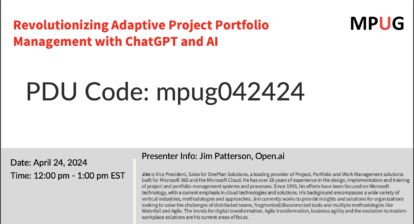
Running a project is akin to reading a book. You have a beginning (otherwise known as the project charter) and an ending (the project closeout). A book consists of many chapters, just as there are numerous “highs” and” lows” of running a project. In the following article, I’d like to make some suggestions that I hope will give you more project “highs” than “lows.” Considering these factors will improve your project’s performance and credibility. Furthermore, your chances of having a successful project that comes in on time and under budget will increase!
- The single greatest factor that can make or break a project is the degree of discipline exercised by the project’s leadership. This is the glue that holds it all together and is often most evident in the managing of a project’s schedule.
- If, for some reason, your project falls behind, the last parameter to be cut should be quality—you need deliberate discipline to do this. If your project’s finish date is fast approaching and you know it will be later than planned, you might consider crashing it by adding more resources to your tasks. Be aware that crashing sometimes doesn’t work and might even increase the duration to finish of the project. Why? You will likely be using second-string resources that need time and supervision to get up to speed. This might cost productivity of original resources, as they will inevitably have to pause to help the new people. The following saying holds true for many projects: We never have enough time to do it right, but we always find time to do it over.
- Communication is the oil that keeps a project running smoothly. Project managers (PMs) may spend up to 90% of their time on internal and external communications, including status tracking and reporting processes. In fact, a recent PMI research survey indicates poor communication is the primary factor in 30% of failed projects.
- Document project boundaries and assumptions in your scope statement and discuss in detail with the client, so you can uncover hidden assumptions and pet deliverables. The client can then decide if their updated requests are worth the price or should be moved to a follow-up project instead. Going through this process will increase your chances of project success.
- A PM needs to find the balance between speaking and listening. Most people are more intent on speaking, but learning to become a better listener is the best way to get a true reading on another person or situation. This, more often than not, requires firm concentration and taking notes on key words or phrases. It’s an invaluable skill for a PM to have. Remember that the listener gains knowledge when their ears and mind are open.
- Foster teamwork among your resources. The more participation is encouraged, the greater the likelihood that a project’s objectives will be met. Treating others as you would like to be treated (i.e., following the Golden Rule) shows respect for the individual and that can add value. Projects run best when employee morale is high. Encourage coaching! The process of skill development needs to be established and pursued for future leaders. This also, fosters teamwork.
- When dislocated teams are working together, use videoconferencing technology to simulate face-to-face conversations. Also, be sensitive to time zone and cultural differences between team members.
- The capability to laugh shouldn’t be underestimated. Displaying a sense of humor helps you to remain cool under pressure and keep problems in perspective. It also adds value to the health—and happiness—of your team.
- Admit when you are wrong. Being stubborn only builds walls between people. You gain respect when you are wrong and have the courage and integrity to say it.
- Try not to delay or surprise people with bad news. The longer you wait, the more it smells like garbage. When I give bad news, I follow-up with possible resolutions to fix the problem and ask for input to end on a positive note hopefully gaining greater respect.
- Establishing a risk-supportive environment can allow the imagined to become reality. The leaders of tomorrow are taking risks today. Always be on the “alert” for positive risks (i.e., opportunity for gain) and learn to embrace them, so the probability of success rises. Positive risks could be listed in the project charter with their associated benefits. Regardless, they should at least be documented as part of the project’s “Lessons Learned” adding value to future projects.
- Crisis management is much more expensive than risk management. So, make sure you spend enough time on your project’s risk management.
- Continually use your chosen process (or methodology), but remember no process is 100% perfect in its’ original design. Changing business needs will continue to challenge the process for improvement. No approach is one size fits all. To survive, organizations have to continually redefine themselves at a faster and faster pace to keep up with their competition.
As people are not perfect, projects are natural breeding grounds for discord. This can result in ineffective human behavior, which must be dealt with effectively for the overall success and health of a project. In the last 30-40 years, the growth of technology has been mind-boggling, but unfortunately not for the rapid growth of processes/methodologies. PM’s need to change (i.e., upgrade job skills) with the times and become champions of these changes or they could be left behind. As you likely know, being a PM can be a challenging and a rewarding job! What other tips would you add to those I’ve listed?







